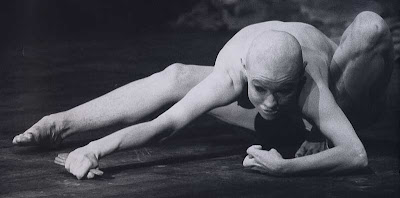

 字體:小 中 大
字體:小 中 大 |
|
|
|
| 2008/09/14 01:17:16瀏覽2171|回應1|推薦8 | |
想像自己將一顆生雞蛋含在口中,並且在大腿股的中間夾一顆馬鈴薯,然後彎下身體,閉上眼睛,以半蹲的姿勢像一個老婦人一樣,往後走。你慢慢地蹲下接近地面,然而你還是保持著兩大腿靠攏的姿勢,你保護著你脆弱的部分。還沒結束,你必須找到另外一個人,想辦法和他(或她)交換你大腿股中間的馬鈴薯。 這樣的畫面真是撼動啊:一個畫上白色的臉和白色身體的舞者,因為能夠充分控制肌肉的延展而緩慢的舞動,並且在未具有任何設定動作的情境下,將身體塑造成在快照之下美麗且怪異的,悲劇且荒謬的呈現。 舞踏,這是在二次大戰戰後由土方撰和大野一雄所創的一種表演。他們企圖推翻傳統舞蹈的概念,並且從中釐出日本的獨特性。舞踏演進至今已經加入許多外來的成分。 我覺得再回頭看較早之前的演出實在是一個美好的經驗。 以下這個演出是土方撰在一九七二年編導的「疱瘡譚」。 你能看出表演者即使具有一個毀壞的身體仍舊試圖表達他的內在嗎? Imagine that there is a raw egg in your mouth and a potato wedged between your thighs. You stoop low with eyes closed, and start walking backwards as an old woman. You are crouching down closer to the ground; still as your two thighs are almost close to each other, you are protecting the fragile part of yourself. There is more. You are to find someone and find the way to exchange the potato, from your perineum to his or hers. It’s fascinating, isn’t it? At least for me, it is. I can almost picture how the whole movement goes: white body and face paint, slow movement based on intense muscular control, and a non-set-up way of molding the body that is as a snapshot to appear beautiful and grotesque, tragic and absurd. It is Butoh, a performance emerged in postwar Japan, led by Tatsumi Hijikata and Kazuo Ohno, who sought to subvert conventional notions of dance and embody a distinctive Japanese identity. As Butoh has evolved and mixed with foreign elements, it is always nice to go back to see the earlier performance. This performance (Hoso-Tan, 1972) was directed by Tatsumi Hijikata. Can you see that the performers try to express the inner self even with a decayed body? It is so powerful! **The image is from Nordic Butoh |
|
| ( 休閒生活|影視戲劇 ) |










